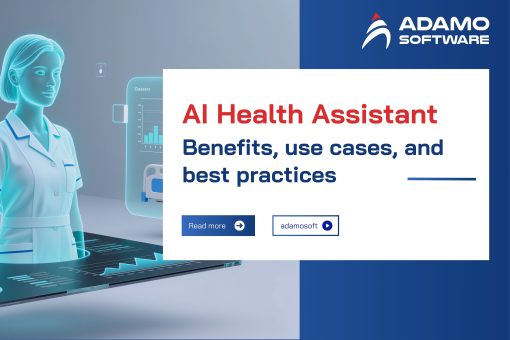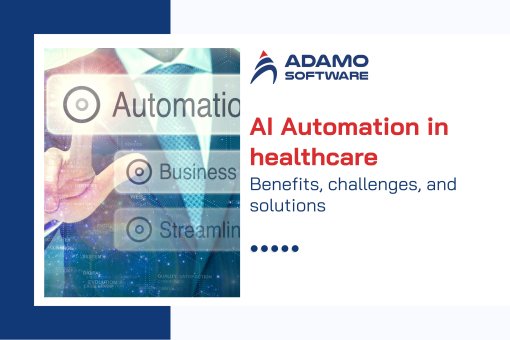How to build successful and robust Custom Patient Portal Solutions
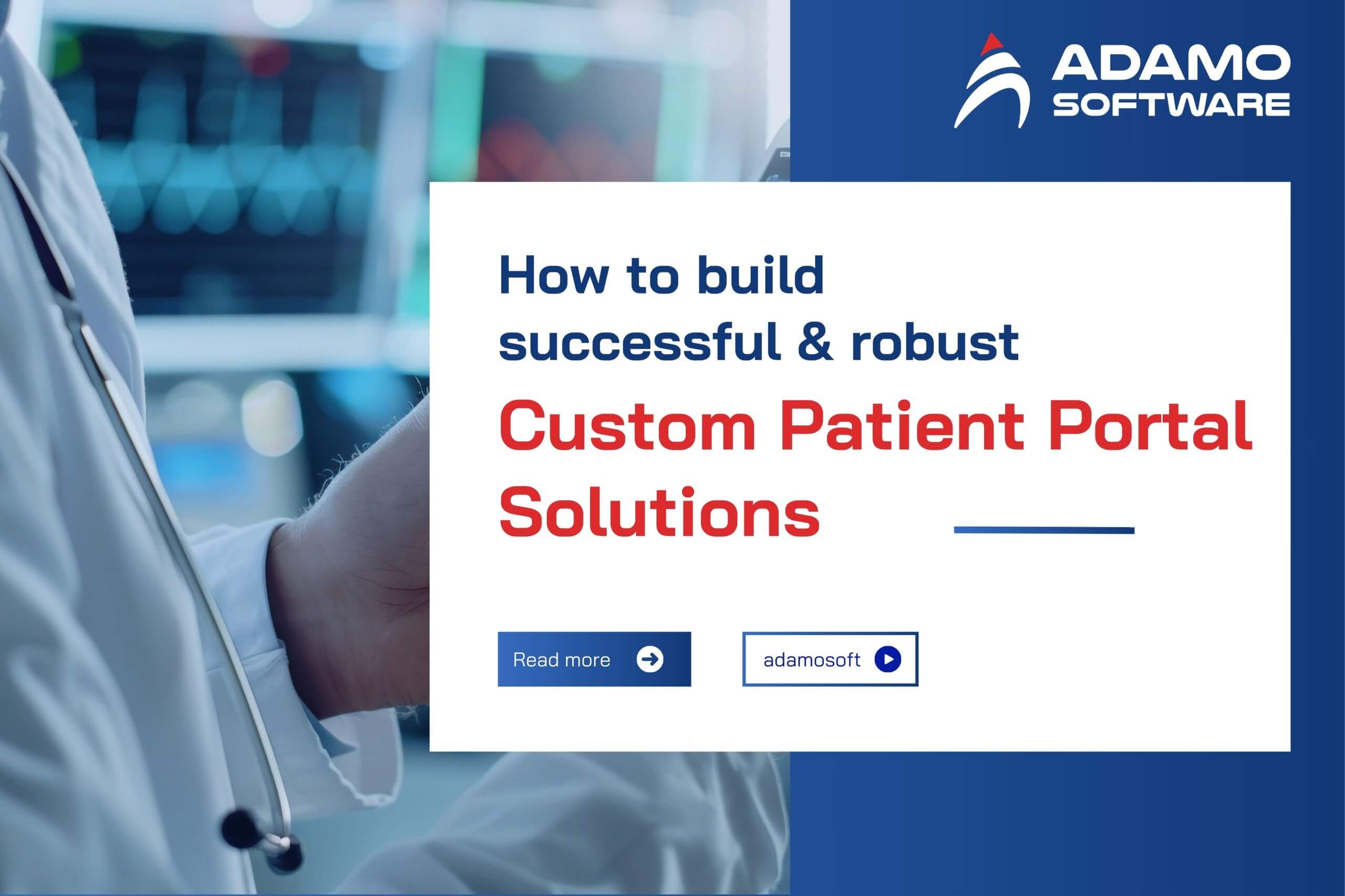
Many industries have gradually started using digital technology in today’s digital age. So does the healthcare sector. One of the most outstanding examples of using digital technologies in this industry is the custom patient portal, which helps healthcare providers manage and exchange information with patients more easily. So, how to build successful and robust custom patient portal solutions? Let Adamo Software answer this question.
Through this blog post, you will find detailed information about what custom patient portal solutions are, why you should develop these solutions, and some key features of these solutions. Besides, you will get a full guideline of the custom patient portal app development. All of these pieces of information have been thoroughly researched and updated to the latest trends. So, let’s read our blog post and find yourself some useful information!
I. What are custom patient portal solutions?
As a global trend, the patient portal is getting more popular, and many healthcare facilities are focusing on developing them. Patients tend to trust and highly appreciate the transparency and convenience of this portal. A patient portal is a digital patient engagement platform, often a website or app, that grants patients access to their medical data. This includes records, treatment plans, prescriptions, test results, and medical images. Additionally, portals empower patients to schedule appointments, make online payments, and communicate directly with healthcare providers.
Beyond a standard portal, many healthcare providers now are using custom patient portal solutions. They are online platforms tailored to meet the specific needs of healthcare facilities and providers. Thanks to these solutions, medical facilities can ensure flexibility, and security, and easily integrate with existing healthcare systems like Electronic Health Records and Hospital Management Software. Besides, these solutions help them optimize healthcare processes, reduce administrative workload, and enhance the patient experience. For more detailed information about the reasons for possessing these custom patient portal solutions, let’s keep reading the next part of the blog!
II. Why You Should Develop Custom Patient Portal Solutions
Thanks to the ability to meet the specific needs of different healthcare facilities, custom patient portal solutions have enhanced patient experiences and satisfaction and optimized the operating process of the medical facilities. So, are they all the reasons why you should develop custom patient portal solutions? Let Adamo Software answer this question.

1. Enhancing patient experience and satisfaction
Enhancing patient experience and satisfaction is one of the notable benefits of the custom patient portal solutions. Thanks to these solutions, patients do not need to go to healthcare facilities to ask for their medical records. Instead, they can manage their health records through the portal. Below are some features that contribute to enhancing patient experience and satisfaction.
- Personal health record viewing: This feature allows patients to track medical treatment history, prescriptions, and test results.
- Online appointment making: Patients can easily make an appointment with doctors, reducing waiting time.
- Online consultant services: Provide better communication between patients and doctors. Patients can communicate with doctors through video calls and chat, which is extremely useful for remote treatment.
Thanks to these features, patients can experience fast, convenient, and seamless services. This helps healthcare facilities promote their reputation.
2. Optimizing healthcare facilities’ operating process
Custom patient portals streamline healthcare operations by automating manual tasks. For instance, instead of manual appointment scheduling, healthcare staff can utilize the portal, reducing errors and optimizing time for both medical professionals and patients. This ultimately saves resources and improves overall efficiency for hospitals and medical centers. Online payment portals streamline billing processes by allowing patients to pay bills directly. This reduces the workload for both the accounting department and cashiers.
Moreover, the document and record management feature empower patients to upload and store their own medical documents. This reduces the administrative burden of paper-based records for healthcare facilities. Overall, thanks to these custom patient portal solutions, hospitals and clinics can optimize human resources, focusing more on patient care activities.
3. Enhancing security and compliance
The custom patient portal solutions help medical centers protect personal information and sensitive patient data through advanced security measures. Below are some main security measures.
- Data encryption: The patient data and information will be encrypted before being transmitted over the network to prevent unauthorized access.
- Multi-factor authentication: Only authorized individuals can access health information.
- Access management: Custom patient portal solutions help to specify who has access to and can manipulate patient data.
- Complying with healthcare regulations: The custom patient portal solutions are designed to comply with international security standards such as HIPAA (in the US) or GDPR (in Europe).
Thanks to these features, healthcare facilities can protect patient data, prevent cyberattacks, and thoroughly understand and comply with security requirements.
4. Improving integration ability and healthcare data management
Another reason to develop custom patient portal solutions is to improve integration ability and healthcare data management. Instead of separate systems, custom portals can integrate with electronic medical records (EMR) or hospital management software (HMS). This helps to synchronize medical data, avoiding information duplication errors.
With a custom portal, healthcare providers can monitor and update patient information in real time. These systems provide detailed reports supporting medical facilities to make better strategic decisions. In general, thanks to the seamless integration capability, hospitals can optimize operating processes and ensure the consistency of medical data.
5. Increasing competitive advantages
Using custom patient portal solutions, medical facilities can increase their competitive advantages in the context where more private clinics and international hospitals are built. These systems help healthcare facilities increase patient loyalty through seamless experiences and personalized services. Patients tend to return to a healthcare facility in the future if they trust that facility.
Besides, with custom patient portal solutions, healthcare facilities can promote their brand more professionally. Moreover, these solutions allow medical centers to expand new features, such as chatbot integration or AI support, to meet changing patient needs. Overall, possessing a tailored patient custom helps hospitals and clinics maintain their competitive advantage, attract new patients, and retain existing patients.
6. Reducing operating costs and enhancing efficiency
Custom patient portal solutions help reduce operating costs and enhance efficiency by automating processes and optimizing human resources. Below are some positive cost impacts of these systems.
- Reducing administrative staff requirements: The online appointment scheduling and payment function of the system helps to reduce the workload on the front desk and cashiers.
- Eliminating manual errors: Automated systems help reduce human errors, thereby saving on error correction and operational costs.
- Environmental solutions: Custom patient portal solutions convert paper documents into digital documents, which reduces the need for paper and saves storage space.
In general, these custom solutions offer many benefits to patients and healthcare facilities. They help patients connect with doctors, know their healthcare condition, and promote trust while enhancing medical facilities’ work efficiency. So, what are the needed features of custom patient portal solutions? Let’s find the answer with Adamo Software!
III. Key features should be added to patient portal solutions
As mentioned, custom patient portal solutions bring many benefits to both healthcare providers and patients. Below are some essential features of these systems that you need to consider optimizing user experience and enhance operating efficiency.
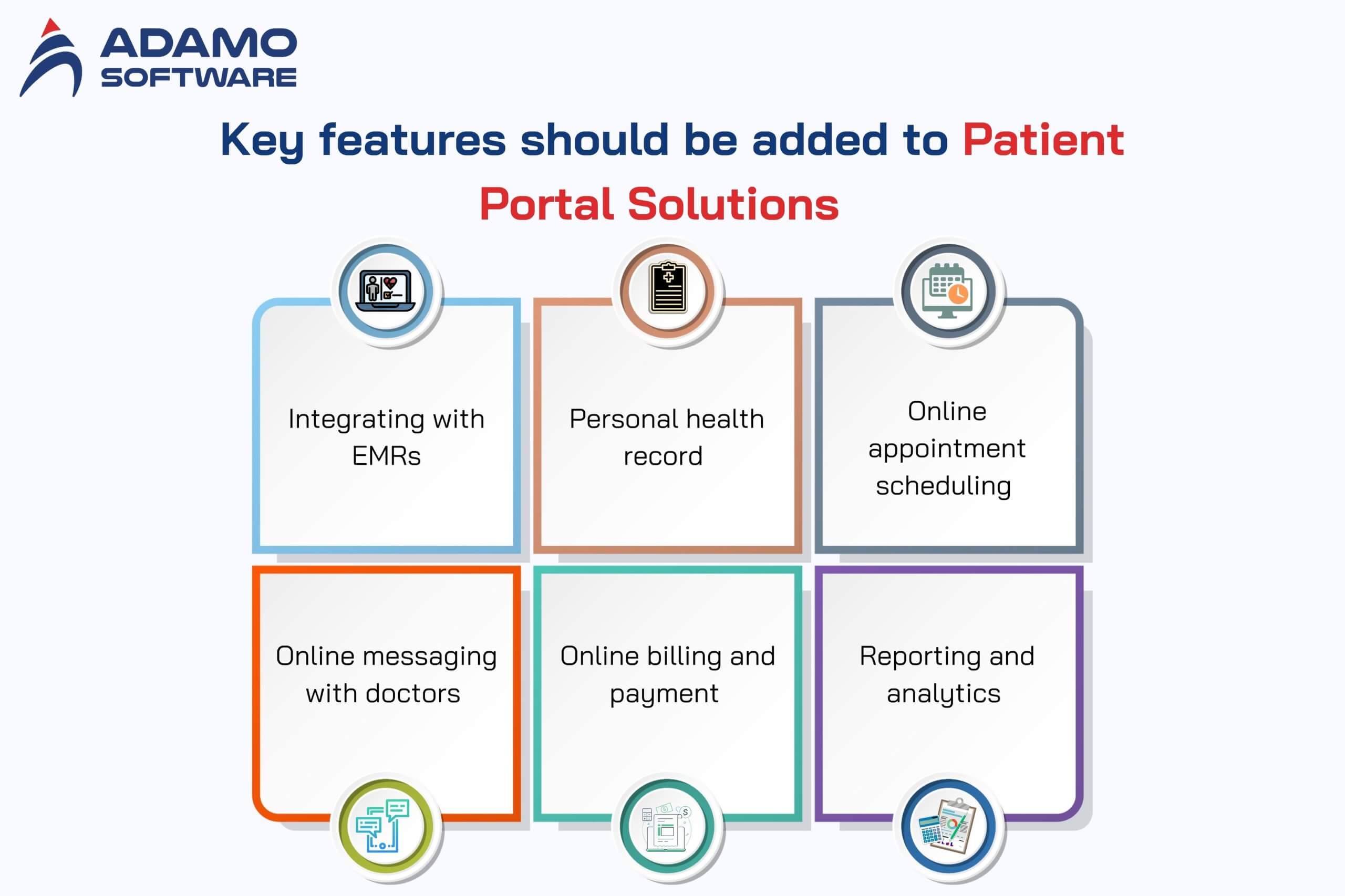
1. Integrating with Electronic Medical Records (EMRs)
EMR refers to medical records that a particular healthcare facility privately owns. It can be a hospital, a polyclinic, or a specialist clinic. Through the EMR system, doctors can use the information collected to diagnose and treat their patients. Thus, the ability to integrate with this system is one of the indispensable features of custom patient portal solutions. This feature ensures that the patient data is synchronized with the existing medical records.
Thanks to this feature, healthcare facilities can access and edit patient medical records right in the portal. Besides, sharing data between healthcare facilities and doctors becomes easier. Moreover, this feature also helps to avoid data inconsistencies between systems, minimizing treatment errors. Overall, integrating with EMRs helps hospitals and clinics improve healthcare processes, thereby improving service quality.
2. Personal health record
The personal health record feature is needed for custom patient portal solutions. This helps patients access their medical information anytime, anywhere. Below are some main functions of this feature.
- Viewing medical history: This function allows patients to view their previous visits, diagnoses, treatments, and medications used.
- Tracking test results: With this function, patients can view the latest test results without having to return to the hospital.
- Storing medical documents: This function enables patients to upload and manage medical documents, such as test results from other medical facilities.
In general, this feature helps patients have the right to control their medical data, while also assisting doctors in making more accurate diagnoses.
3. Online appointment scheduling
Online appointment scheduling is one of the most popular features of custom patient portal solutions, which brings convenience to both healthcare facilities and patients. With this feature, patients can choose the date, time, and doctor according to their needs. Automatic reminders will be sent via email, SMS, or app notifications so that patients won’t miss any appointments with doctors. Besides, this feature also allows patients to change or cancel appointments online without calling.
4. Online messaging with doctors
Online messaging is also among the important features of custom patient portal solutions, especially in the context of increasing demand for remote medical care. Here are some forms of online messaging.
- Secure messaging: this form allows patients to send messages directly to doctors and receive responses constantly.
- Telehealth: Remote consultations can be made through live videos or audio calls with doctors.
- Chatbot AI: Through this form, patients can receive answers to their symptoms and treatment procedures automatically.
Overall, this feature helps to save time for both patients and healthcare providers and reduces pressure on medical facilities.
5. Online billing and payment
All custom patient portal solutions must have online billing, and payment features so that patients can easily pay for the services they use without complex processes. With this feature, patients can pay their medical bills without having to visit the hospital in person. Below are some key functions of the online billing and payment feature.
- Calculating and displaying bills: Patients can view detailed treatment costs, including examination fees, tests, and other fees.
- Online payment: The custom patient portal solutions support many payment methods, such as credit cards, e-wallets, or bank transfers.
- Storing invoices and receipts: Patients and healthcare providers can track and check patient payment records through this function of the system.
Generally, this feature helps to enhance patient experience and allows medical facilities to optimize the fee collection process and minimize errors in financial management.
6. Reporting and analytics
Reporting and analytics are also key features of custom patient portal solutions. They provide data on patient behavior, which helps healthcare providers improve their services. Through this feature, medical centers can monitor trends in patient health and behavior.
Besides, healthcare service performance and patient experience can be measured through performance reporting. Additionally, the collected data also supports medical facilities in predicting patient’s potential health issues. Overall, the reporting and analytics feature helps healthcare providers make data-driven decisions, optimize operations, and improve patient care.
In general, the above features are essential in custom patient portal solutions. They help improve the user experience and enhance the operational efficiency of healthcare facilities. Each feature plays an important role in optimizing healthcare systems.
IV. Custom Patient Portal App Development: A full guideline
To develop successful and robust custom patient portal solutions, you may want to follow a strict process. In this part of the blog, Adamo Software will provide you with tech stacks to develop the custom patient portal and steps to develop the app.
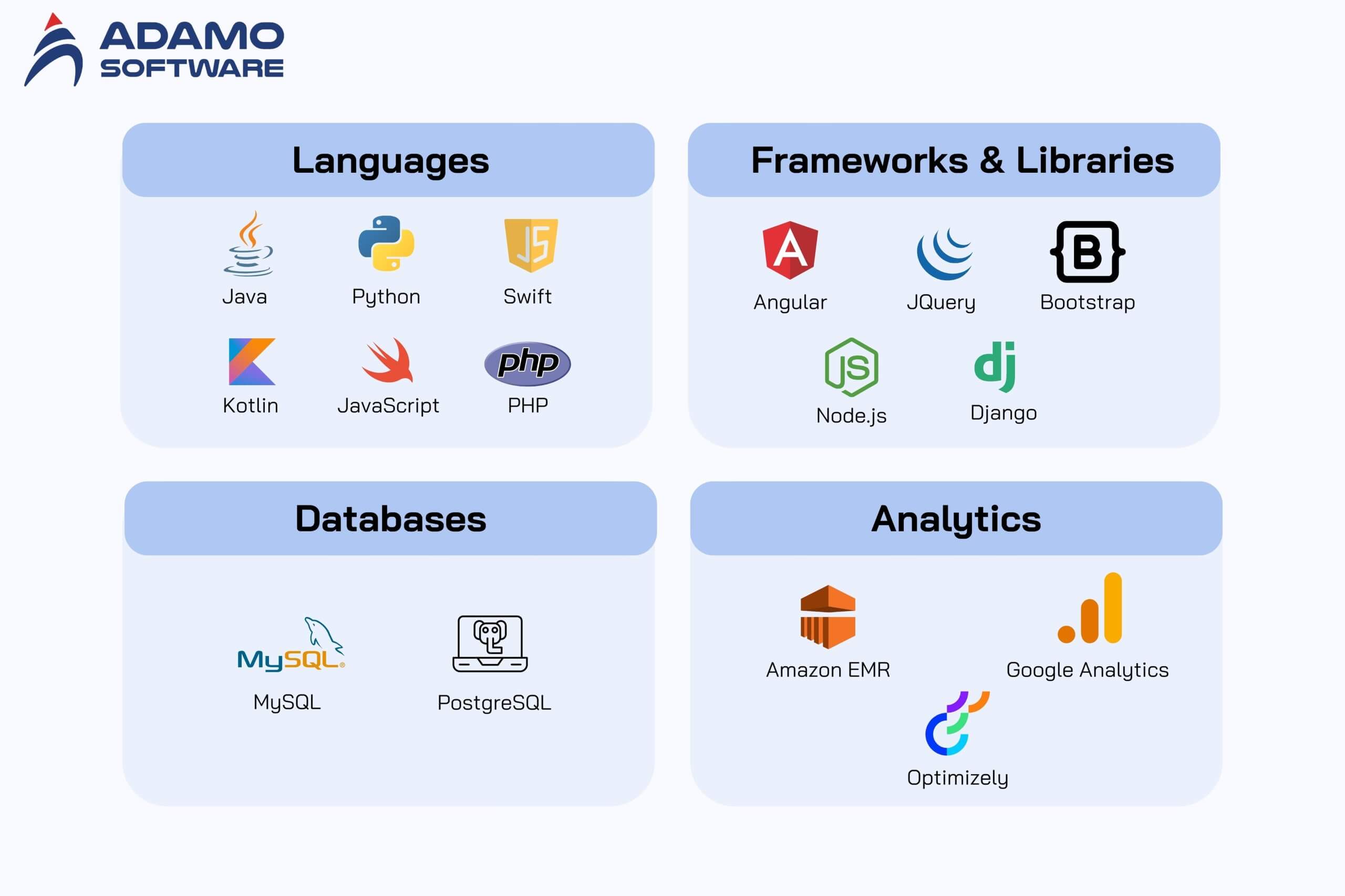
1. Tech stacks for a custom patient portal
Before coming to the steps to develop your custom patient portal solutions, you may want to know some technology choices for building a patient portal. Below are some popular technologies.
- Programming languages: HTML, CSS, JavaScript, TypeScript (Frontend); React, Angular, or Vue.js (Frontend Frameworks); and Node.js, Python, and Java (Backend).
- Database: MYSQL, PostgreSQL, Firebase Realtime Database, etc.
- Frameworks and libraries: Node.js, Bootstrap, Angular, etc.
- Analytics: Amazon EMR, Google Analytics, etc.
- Web server: Apache HTTP, nginx
- Utilities: Cloudflare, Microsoft Azure, Amazon s3, etc.
2. Steps to develop custom patient portal solutions
If you want to develop custom patient portal solutions, you will have to follow a detailed, methodical, and user experience-focused process. Let’s explore each step with Adamo Software!
3. Analyzing requirements and goals
Before developing customs patient portal solutions, you must identify the goals and requirements of the portal. Below are some main tasks in this step.
- Defining patient and healthcare providers’ needs: the systems must meet the needs of both patients and healthcare providers, including the ability to access medical profiles schedule appointments, and communicate between doctors and patients.
- Function analytics: you must list the needed features of the custom patient portal solutions, such as managing medical data, online payment, reporting plan, and analytics, as mentioned above.
- Identifying legal requirements: you must ensure that the system complies with security requirements like HIPAA and GDPR.
4. Planning and designing
Once you have identified the goals and requirements of the custom patient portal solutions, you must plan and design the UX/ UI for the system. After finishing this step, you will complete the interface design samples (wireframe, prototype) and detailed development plan. Here are some works you must do in this step.
- Choosing appropriate frameworks, technologies, and platforms for development
- Determining how users interact with the app
- Designing the user interface (UX/ UI), creating a prototype and mockup of the interface
- Creating a detailed development plan for completion time of each stage
5. Development and integration
Now, it’s time for you to develop your patient portal app and integrate it into the existing system of healthcare facilities. In this step, you will leverage different tech stacks mentioned above for custom patient portal solutions. Besides, you must integrate the app with electronic medical records (EMR/EHR) to synchronize medical data. Besides, let’s implement security features like data encryption, multi-factor authentication (MFA), and access control.
6. Testing and quality assurance
Before officially launching the custom patient portal solutions, you must conduct the testing and quality assurance steps to ensure that these solutions are stable, secure, and error-free operation. Below are four types of testing you must do.
- Functional testing: This testing ensures that all key features are working correctly.
- Security testing: This testing checks for security vulnerabilities such as data breaches, XSS attacks, or SQL Injection attacks.
- Performance testing: Evaluating the application’s page load speed, latency, and performance under high load.
- Compatibility testing: This testing checks the application’s ability to work on a variety of devices and browsers.
7. Deploying and launching
The next step after testing is deploying and launching your custom patient portal solutions. When you finish this step, patients and healthcare providers can directly use your app. Below are some important tasks in this step.
- Prepare the production environment: Configure servers, databases, and cloud services (AWS, Google Cloud, Azure).
- Data migration: Migrate data from legacy systems to the new portal if needed.
- Deployment testing: Perform a final test to ensure the application is stable in a production environment.
- Go-Live: Publish the application on app stores (App Store, Google Play) or deploy directly to healthcare facilities.
8. Monitoring and maintenance
Your custom patient portal solutions must be monitored and maintained regularly to ensure the application is stable and updated with new features. In this step, you will monitor the bug, update new features, support users, and maintain security for your app. Thanks to this, your app can operate stably and has the ability to expand and update regularly to improve user experience.
In general, developing custom patient portal solutions is a complex process that requires close coordination from planning, and development to deployment and maintenance. By following the above steps, you can create a custom solution that is efficient, user-friendly, and highly secure.
V. Let Adamo be your trusted partner in developing the custom patient portal app

As one of Vietnam’s leading healthcare technologies, Adamo Software can be your trusted partner in developing the custom patient portal app. Here’s how Adamo can help you with your idea.
- Consulting development strategy
Adamo Software provides strategic consulting services for developing custom patient portal solutions. We can help you propose the essential elements for an effective patient portal by analyzing business needs and healthcare environments.
- Developing custom software
Based on different needs and requirement, Adamo can customize your patient portal app. With custom patient portal solutions from Adamo, you can offer the best experience for patients, from optimized user interface (UI/UX) to hospital-specific functionality.
- Data integration and synchronization
Adamo supports the integration of EHR/EMR systems such as Epic, Cerner, and FHIR API to ensure patient data is synchronized and easily accessible. This solution provides real-time access to information, increasing accuracy and transparency in patient care.
- 24/7 maintenance and technical support
Adamo Software can ensure the stability of the custom patient portal solutions with 24/7 technical support and after-sales service. Upgrades and bug fixes are provided promptly to ensure a continuous and seamless user experience.
Still hesitating whether to choose Adamo Software? Let’s contact us for more detailed information.







